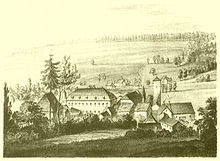Reign of Farnroda
The Farnroda lordship was a territorial administrative unit whose jurisdiction was under noble lords. Over the course of time, suzerainty lay with the Landgraves of Thuringia and later with various Ernestine Duchies , most recently with the Duchy of Saxony-Eisenach . Initially, the area was under the "Lords of Farnroda", who sold it in 1461 to the burgraves of Kirchberg . After their extinction, the area fell to the Duchy of Saxony-Weimar-Eisenach in 1799 , which in 1815 became the Grand Duchy of Saxony-Weimar-Eisenach.
Until the administrative and territorial reform of the Grand Duchy of Saxony-Weimar-Eisenach in 1850 and the associated dissolution, it formed the spatial reference point as a rule or office for the collection of sovereign taxes and compulsory services , for the police , judiciary and army successes .
Geographical location
The rule of Farnroda lay between the northwestern Thuringian Forest in the west and the Hörselberge in the east. In the ruled area, the Burbach and the Erbstrom flowed into the Hörsel . The places Burbach and Seebach were only connected to Farnroda via a small land connection.
The ruled area is now in the west of the Free State of Thuringia and belongs to the communities of Wutha-Farnroda and Seebach in the Wartburg district .
Adjacent administrative units
The Farnroda dominion bordered on the following areas:
- North and West: Amt Eisenach (Duchy of Saxony- (Weimar-) Eisenach)
- East: Wangenheim court in Winterstein (Duchy of Saxony-Gotha)
- South: Uetterodtschesgericht (Duchy of Saxony-Gotha)
history

The "Lords of Farnroda", first mentioned in a document in 1260, were the castle men of the Farnroda moated castle . The place Farnroda was first mentioned in 1272/78. The "rule Farnroda" which the lords of Farnroda from wettinischen Landgrave of Thuringia to fief received, included not only Farnroda among other Eichrodt, Wutha, Seebach and Burbach. The Lords of Farnroda had high and low jurisdiction in the rule . In the middle of the 15th century, the heavily indebted Lords of Farnroda had to sell their home lands.
In 1461, the burgraves of Kirchberg acquired the Farnroda rule after they had lost their previous property in the Saale valley near Jena . Around 1600 the traces of the Lords of Farnroda are lost. The Kirchbergers succeeded them with the consent of the Duke of Saxony-Eisenach and also took over the estate near the moated castle. A half-timbered house built in the Renaissance style was built in the area of the manor. Farnroda Castle, which burned down in 1620, was rebuilt in 1677. In 1799, the last person entitled to inherit from Kirchberg died, so all property fell to the Duchy of Saxony-Weimar-Eisenach as a settled Landgrave-Thuringian fief . As a successor, the wealthy house in Sayn-Wittgenstein received the Farnrodaer property.
In 1815 the Duchy of Saxony-Weimar-Eisenach was made a Grand Duchy. In 1849/50, jurisdiction was separated from administration in the Grand Duchy . The existing patrimonial courts were also repealed. The rule of Farndroda came with other offices in the Eisenach district to the Eisenach administrative district , also known as III. Administrative district was designated. With the introduction of the new court system in 1879, the area was incorporated into the Eisenach district court.
Associated places
- Villages
- Yards

- Burbach
- Vorwerk Hucheroda
- a farm in Schönau an der Hörsel (the place itself belongs to Saxe-Gotha)
- Rehhof
- Castles and Palaces
- Desolation
- Berzingeroda
- Wittgenstein Castle
swell
literature
- Kronfeld, Constantin: Thuringian-Saxon-Weimar history. - Weimar: Böhlau, 1878. - (Regional studies of the Grand Duchy of Saxony-Weimar-Eisenach; T. 1) / [reviewed by:] Ulrich Stechele